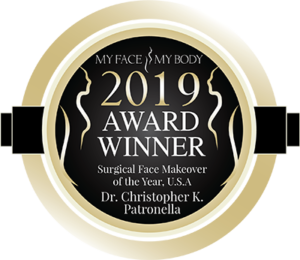Facelift Surgery in Houston, TX
Lines, wrinkles, and sagging skin on the face are three of the most common signs of aging that impact women and men. While every patient is different, these concerns can develop due to sun exposure, harsh environmental conditions, genetics, and certain lifestyle factors.
At some point, skin and underlying facial tissues begin to thin and lose elasticity, allowing gravity to take over. As this occurs, patients may see a more aged and tired appearance when they look in the mirror that cannot be remedied with skin care products.

True Form Facelift®
Facelift surgery restores a youthful appearance by tightening and lifting facial skin and the facia (underlying tissues). Dr. Patronella’s True Form Facelift® provides long-lasting results that never appear artificial or overdone so his patients can have the firm, smooth, younger-looking face and neck they desire without looking overly stretched or pulled.

Why Choose Patronella True Form® Plastic Surgery in Houston?
Dr. Patronella is among the best plastic surgeons in the country, and when you schedule a facelift consultation with him, you’ll know why. He is not only highly skilled and experienced but compassionate as well. He has applied his extensive knowledge to create his proprietary True Form® approach, using advanced techniques that improve results and ease recovery and downtime.
Call our Houston, Texas, plastic surgery practice today at (713) 575-1996 to schedule your facelift consultation.
Am I a Candidate for Facelift Surgery?
Facelift surgery corrects wrinkles, sagging skin, jowls, and volume loss. Individuals who struggle with one or more of these may be a candidate for facelift surgery.
The best candidates for facelift surgery are healthy adults who don’t smoke, can comply with their surgeon’s instructions before and after the procedure, are in good health, and have realistic expectations for their results. Facelift surgery is performed to turn back the hands of the clock, so to speak. Patients can anticipate looking several years younger.
How Is the True Form Facelift® Performed?

Read the facelift testimonial of permanent cosmetic artist and patient of Dr. Patronella Tracy by clicking on her photo.
The True Form Facelift® addresses wrinkles, sagging skin, and volume loss in the mid-to-lower facial areas. This can help to redefine facial areas, such as the midface and jawline.
Under general anesthesia, incisions are made within the hairline and natural ear creases, so scars are virtually undetectable.
Dr. Patronella performs the True Form Facelift® by using a dual-plane facelift technique. This method repositions and tightens the deep facial tissues, muscles, and skin. This approach allows Dr. Patronella to ensure that his facelift results remain natural and his patients don’t end up with a wind-blown appearance.
Once the underlying tissues are tightened, the skin is carefully trimmed and re-draped over the musculature. Finally, the incisions are closed with sutures.
Facelift surgery takes an average of three hours.
What Procedures Are Commonly Combined With Facelift Surgery?
-
A neck lift is typically performed with a facelift for balanced results. Incisions for a neck lift run down and around the ear through which the skin and tissues are tightened. This combination procedure is ideal for patients with vertical neck banding and skin laxity.
-
Blepharoplasty (eyelid surgery) targets aging on the upper and lower eyelids. This procedure ensures that the eyes will match the youthfulness of the lower face after facelift surgery. In severe cases of eyelid drooping, this procedure can increase a patient’s range of vision by repositioning or removing fat pockets and trimming away excess skin.
-
Brow lift surgery addresses aging on the upper region of the face, such as forehead creases and sagging eyebrows, by tightening the underlying tissues and trimming away excess skin. This procedure restores balance and harmony between the upper and lower regions of the face.
-
Injectables like dermal fillers and BOTOX® Cosmetic give patients a more youthful and rejuvenated facial appearance. These treatments restore lost volume or lessen the appearance of lines and wrinkles on the upper face. Injectable treatments can be combined with a facelift or can be an initial treatment option for patients whose aging concerns are not severe enough to require surgery.
-
Non-surgical skin rejuvenation treatments such as laser resurfacing and chemical peels revitalize the skin by improving its tone and texture. These non-surgical treatments can help correct the appearance of hyperpigmentation, acne and acne scars, rosacea, dry skin, oily skin, or highly sensitive skin. These treatments can be performed after recovering from a facelift procedure to extend the longevity of your results or to postpone the need for surgery.
How Long Is My Recovery After a True Form Facelift®?
Facelift patients can expect bruising, swelling, tenderness, and soreness during the first one or two weeks. Prescribed or over-the-counter pain medication and an AqueCool mask can help relieve discomfort and keep swelling to a minimum. During recovery, patients should try to keep their heads upright at all times to ensure proper blood circulation and fluid drainage. Most patients need at least two weeks off from work and their normal activities; however, this depends on the nature of your job. Patients can typically resume exercise and more strenuous activity after six weeks.
When Will I See My Facelift Results?
After facelift surgery, patients can expect to enjoy a more rested and youthful facial appearance. Lines and wrinkles are smoothed, facial volume is restored, and jowls become less noticeable as the jawline is defined. These results can be enhanced further when your facelift is combined with additional surgical or non-surgical cosmetic procedures.
This surgery is known to provide long-lasting results, and patients can extend their facelift results by undergoing periodic non-surgical skin rejuvenation treatments, protecting their skin from the sun and harsh elements, not smoking or overindulging in alcohol consumption, following a healthy lifestyle, and keeping their skin hydrated with pharmaceutical-grade skin care products.
With facelift surgery, Dr. Patronella’s goal is to highlight a patient’s natural beauty by restoring their younger-looking facial contours and eliminating or reducing lines and wrinkles.
A Younger-Looking Face and Neck With a Facelift in Houston, TX
Dr. Christopher K. Patronella, who has been declared one of “America’s Best Plastic Surgeons” for facelift surgery by Newsweek Magazine, offers the True Form Facelift® in Houston, Texas.
If you want natural results from a facelift and live in or can travel to Houston, call (713) 575-1996 to schedule your consultation today!
True Form Facelift® Frequently Asked Questions
Does a facelift make you look stretched?
No, not with the techniques Dr. Patronella uses. Facelift results heavily rely on the skill and experience of the plastic surgeon performing the procedure.
Early plastic surgery techniques traditionally involved pulling the skin back, trimming it, and closing the incisions. Those techniques often left patients with unnatural-looking results. Dr. Patronella uses modern methods that tighten the underlying musculature and restore lost volume to give you a natural-looking result.
How soon after my facelift can I go back to work?
Each person recovers from a facelift operation at a different pace. Depending on the extent of the operation, it may take between three and seven days to feel ready to do your job again. Most people require about two weeks before they feel socially presentable.
However, if your work involves straining or heavy lifting, you might have to wait a bit longer.
How long will my facelift last?
Most facelifts last seven to 10 years, although some patients may require updating their procedure after ten years. Some patients never need another procedure, while others may opt for touch-up surgery down the road.
How should I prepare for a facelift?
Before undergoing a facelift, Dr. Patronella asks patients to stop taking certain medications, smoking, or using herbal supplements in the days leading up to the procedure.
How long does bruising and swelling last after a facelift procedure?
A facelift is likely to produce bruising and swelling for at least 10 to 14 days. Some patients will have prolonged swelling lasting up to three weeks. Dr. Patronella provides his patients with options, such as the AqueCool mask, to reduce bruising and swelling.
What is the best age for a facelift?
The best age for a facelift depends on your appearance and how bothered you are by your signs of aging. Facelifts are most commonly performed for those between 40 and 60 but can be done at any age.


